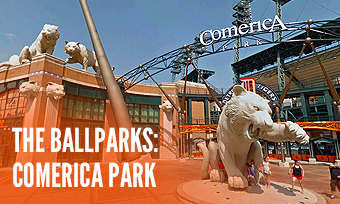THE TEAMS
Detroit Tigers
THE TIGERS BY THE DECADE
The 1900s
The Tigers got off to a rough start both on the field and at the gate, with strong conversation by mid-decade that the franchise would be relocated to Buffalo. But that all changed when the town awoke and embraced the Tigers with the arrival of Ty Cobb, whose ultra-angry demeanor and aggressive, world-class hitting skills propelled Detroit to three straight American League pennants—but no championships, as the Tigers fell flat all three times at the World Series.
The 1910s
As Cobb went, so went the Tigers; the perennial hitting champ constantly made news, often in the worst way—engaging in fistfights with teammates, opponents, fans and everyday people outside the ballpark who somehow incurred his volcanic wrath. Even with Cobb at peak form (on the field, as well as off it), Detroit went pennantless for the decade, despite a 100-win campaign in 1915 that fell shy of first place by 2.5 games. The 1912 opening of Navin Field (later to be renamed Tiger Stadium) would dutifully serve as the team’s home for the rest of the century.
The 1920s
The Tigers could sure hit—as did most baseball teams in the 1920s with the explosion in offense—but Detroit’s bats were especially robust thanks to a superior lineup bolstered by Harry Heilmann and an aging yet still dangerous Cobb; the Tigers’ .316 team average in 1921 still ranks as the highest in AL history. But the Tigers seldom fought for the top as languid pitching offset the crackling offense and kept the team saddled around the .500 mark. Cobb served as the team’s manager through 1926, when allegations (but no hard evidence) of his involvement in game-fixing back in 1919 forced him to relinquish his duties.
The 1930s
A five-year malaise was shattered in 1934 when catcher Mickey Cochrane was exiled from Philadelphia, took over the Tigers’ managerial duties and shot Detroit back to winning form with two consecutive pennants in 1934-35—including, at last, its first World Series title in 1935 just weeks before long-time owner Frank Navin died. Not surprisingly, offense was behind the Tigers’ return to the top with “Mechanical Man” Charlie Gehringer and towering slugger Hank Greenberg contributing with phenomenal numbers.
The 1940s
After another pennant in 1940 led to an emotional World Series loss to Cincinnati, the Tigers slipped to middling status during World War II with many star players—most notably Greenberg—absent to aid the war effort. Exceptional pitching led by Hal Newhouser and Dizzy Trout emerged during the war and, along with the early return of Greenberg midway through 1945, gave the Tigers an exciting AL pennant and seven-game Fall Classic triumph over the Chicago Cubs. Newhouser continued to rule the mound in the immediate postwar years, but Greenberg’s decline and trade to Pittsburgh signaled the end of an era—and the start of a lesser one.
The 1950s
The Tigers imploded early in the decade, bottoming out with 104 losses in 1952—then revived back to respectability with the maturing of outfielder Harvey Kuenn, a young Al Kaline (who became the majors’ youngest-ever hitting champ at age 20 in 1955) and prosperous pitching toward the end of the 1950s with Jim Bunning and Frank Lary taking hold atop the rotation. But the Tigers never made any move for the pennant, frequently and maddeningly trailing the same three teams: The New York Yankees, Cleveland Indians and Chicago White Sox.
The 1960s
In a decade where Ty Cobb was sorely needed, the Tigers (.247 average for the 1960s) made up for undisciplined hitting with stark power, starting with Norm Cash’s monster 1961 season and later with a batch of guys (Willie Horton, Jim Northrup, Bill Freehan) contributing just north of 20 homers a year. Despite a decade-low .235 average in 1968, the Tigers won 103 games—31 from colorful and controversial ace Denny McLain, the majors’ last 30-game winner—and outlasted the Cardinals in a feisty seven-game World Series.
The 1970s
The Tigers managed one more postseason appearance in 1972 before fading into rebuild mode—a movement that most notably yielded the loyal and exemplary middle infield duo of Lou Whitaker and Alan Trammell, who would team together for 19 straight years in Detroit. The unquestioned highlight of the decade belonged to flamboyant one-year wonder Mark Fidrych, whose long curly hair, on-mound theatrics and pitching excellence captivated both Detroit and the nation in 1976.
The 1980s
Detroit lucked into ex-Cincinnati manager Sparky Anderson, who gradually nurtured the Tigers to championship form in 1984 with one of the game’s most dominant campaigns—sprinting out to 35-5 start, overwhelming the AL East competition and breezing through the postseason for a made-to-order world title behind the spirited leadership of outfielder Kirk Gibson and closer Willie Hernandez. A dynasty was not in the cards, however; the Tigers stayed solid but made just one more playoff appearance in 1987, being upset at the ALCS by Minnesota.
The 1990s
Gripping it and ripping it was the name of the game to start Tiger Stadium’s final decade in operation as an undisciplined yet potent Detroit roster heavy on home runs, walks and strikeouts dictated success and failure; more than not, it was the latter. Cecil Fielder’s 51 homers in 1990—the first 50+ effort by an American Leaguer in 29 years—presaged the booming decade to come for baseball in general. Thoroughly lackluster Tigers pitching hit a historic rock bottom in 1996 by posting an AL record-worst 6.38 earned run average.
The 2000s
Comerica Park ushered in the new century, infuriating hitters who detested its expansive outfield before the Tigers modified the dimensions. The new ballpark failed to give Detroit an upward bump in the standings; on the contrary, the Tigers sank all the way to 119 losses in 2003 to set an AL record. From the ashes of that disaster, veteran manager Jim Leyland took over and, as he did in Pittsburgh, turned a lost franchise completely around with an AL pennant just three years later.
The 2010s
The momentum accelerated into the 2010s as the Tigers took four straight divisional titles (their first since the 1980s), one leading to a second pennant under Leyland in 2012. During this stretch, Detroit cornered the market on MVPs, with ace pitcher Justin Verlander being awarded in 2011 followed by back-to-back honors for Miguel Cabrera—who, in 2012, also became the game’s first triple-crown winner since 1967. But owner Mike Ilitch’s liberal spending ways came to an end when he passed away in 2017; his son Chris inherited the franchise and took on a far more fiscally conservative approach, leading to a major shedding of talent and a hard rebuild at decade’s end.
The 2020s
A much-anticipated youth movement labored to take hold as high-end prospects Casey Mize, Spencer Torkelson and Riley Greene struggled to make immediate impressions. Rising out of this grounded flock was ace Tarik Skubal, whose back-to-back Cy Young Awards at mid-decade burst the Tigers from anonymity to the postseason for the first time in 10 years—giving hope for long-suffering Detroit fans that the team has finally turned the corner.
Highlights of the Tigers’ History on This Great Game:
 1907: Cultivation of a Georgia Peach Angrier than life, Ty Cobb comes of age and delivers the Tigers with their first pennant.
1907: Cultivation of a Georgia Peach Angrier than life, Ty Cobb comes of age and delivers the Tigers with their first pennant.
 1909: Three-Beat Sudden ace Babe Adams of the Pittsburgh Pirates stifles the Tigers into their third straight World Series loss.
1909: Three-Beat Sudden ace Babe Adams of the Pittsburgh Pirates stifles the Tigers into their third straight World Series loss.
 1910: A Carload of Trouble The World Series becomes anticlimactic following a strange and controversial ending to the individual batting race between two of baseball’s premier hitters: The Tigers’ Ty Cobb and Cleveland’s Nap Lajoie.
1910: A Carload of Trouble The World Series becomes anticlimactic following a strange and controversial ending to the individual batting race between two of baseball’s premier hitters: The Tigers’ Ty Cobb and Cleveland’s Nap Lajoie.
 1935: The Babe’s Bittersweet Bow Out In Babe Ruth’s final season as a player, the Tigers take advantage of the vacuum left by his decline at New York and tackle the Chicago Cubs in their latest attempt to finally win a World Series.
1935: The Babe’s Bittersweet Bow Out In Babe Ruth’s final season as a player, the Tigers take advantage of the vacuum left by his decline at New York and tackle the Chicago Cubs in their latest attempt to finally win a World Series.
 1940: Victorious Healings The Tigers and Cincinnati Reds, two teams coping with personal loss, dedicate themselves toward winning a World Series title.
1940: Victorious Healings The Tigers and Cincinnati Reds, two teams coping with personal loss, dedicate themselves toward winning a World Series title.
 1945: Hank’s Heroic Rescue As World War II comes to an end, the Tigers’ Hank Greenberg makes the first and most celebrated return to baseball.
1945: Hank’s Heroic Rescue As World War II comes to an end, the Tigers’ Hank Greenberg makes the first and most celebrated return to baseball.
 1968: Year of the Pitcher The side effects of the increased strike zone reach epidemic proportions as amazing pitching feats abound everywhere—and become the centerpiece for a memorable seven-game World Series between the Tigers and St. Louis Cardinals.
1968: Year of the Pitcher The side effects of the increased strike zone reach epidemic proportions as amazing pitching feats abound everywhere—and become the centerpiece for a memorable seven-game World Series between the Tigers and St. Louis Cardinals.
 1984: The Roar of a Powerhouse The Tigers bolt out to a 35-5 record and coast from their to their first World Series title since 1968.
1984: The Roar of a Powerhouse The Tigers bolt out to a 35-5 record and coast from their to their first World Series title since 1968.
 2006: Two Reluctant Enemies Best of friends, Tony La Russa and Jim Leyland overcome various hurdles and face off against one another in October.
2006: Two Reluctant Enemies Best of friends, Tony La Russa and Jim Leyland overcome various hurdles and face off against one another in October.





